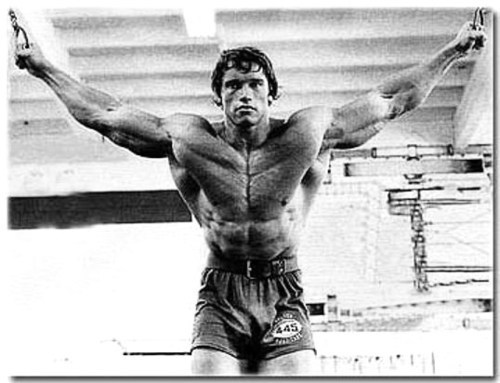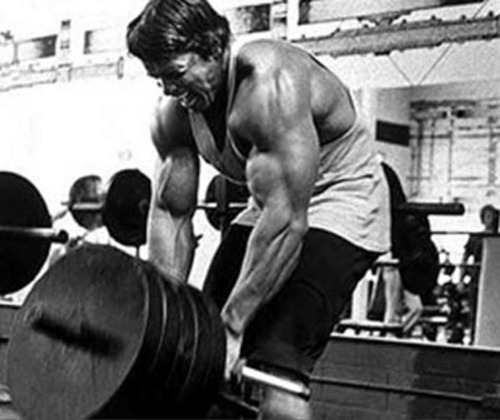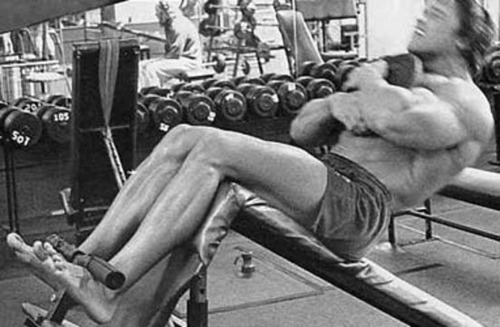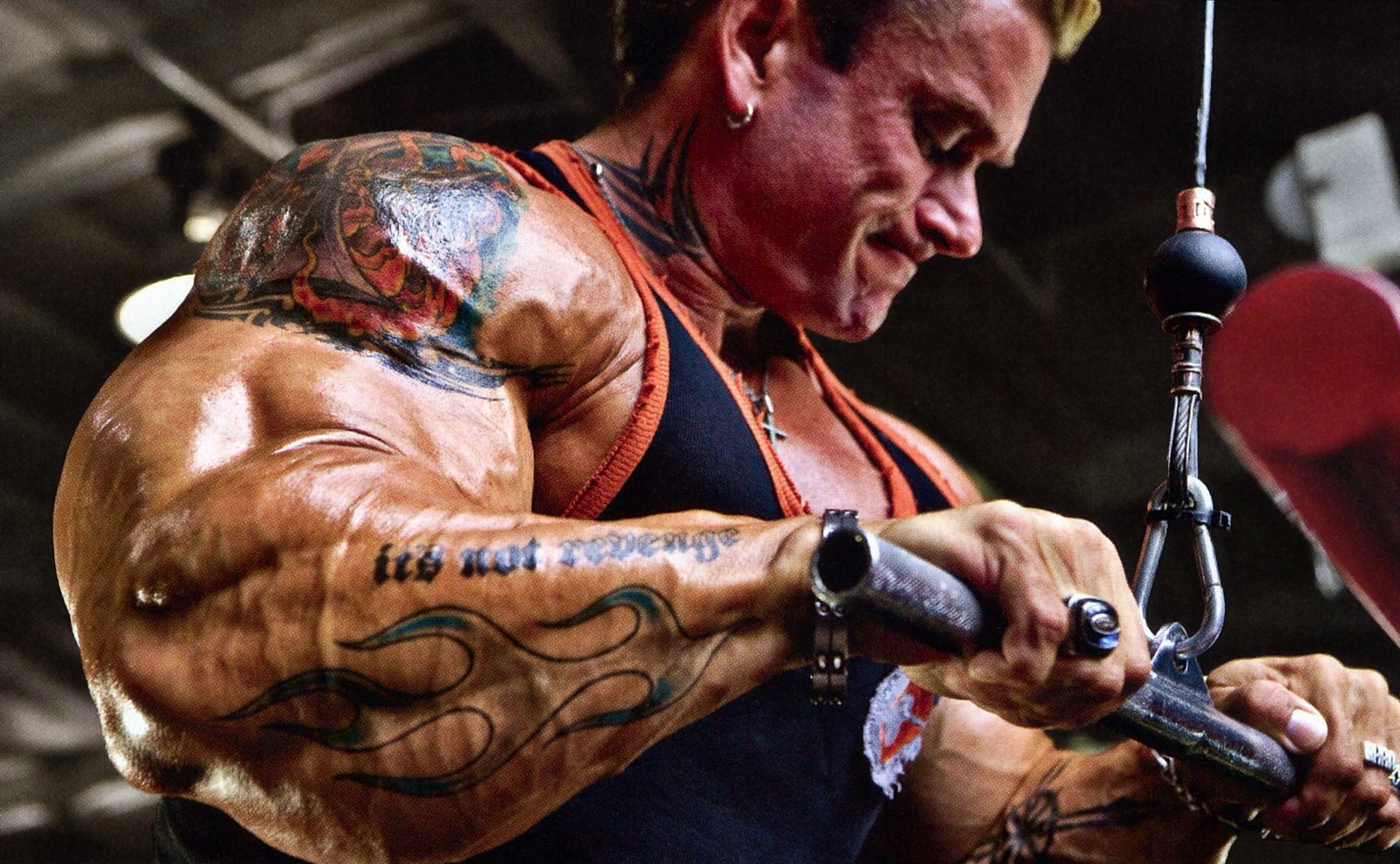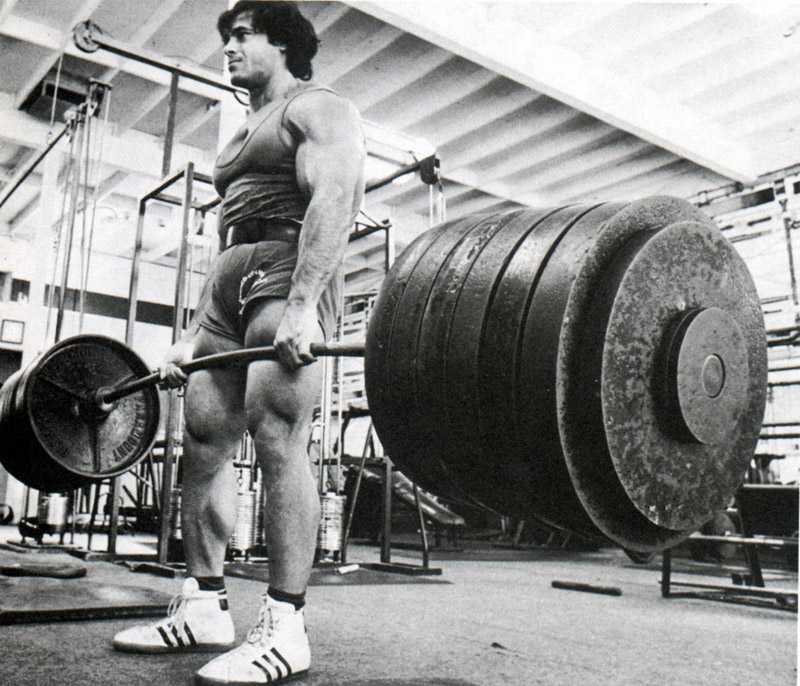Warning
Honestly, you don't have the
balls to use the advanced training principles I'm about to outline in this article. This training method usually only works with elite, coached athletes — athletes forced into the gym and driven into the ground by a hard-driving international level coach.
The training is brutal. Your body will scream. The psychological effect is agonizing. Your mind will rebel.
You
will want to quit. You
will want to screw with the program to make it physically and mentally easier. Very few of you will even attempt this type of training.
That's good. Most people shouldn't even try it. It's not for them. It very likely isn't for
you. You can't handle it.
In spite of all of the above, the editors of Testosterone have talked me into writing about this type of training. But you've been warned.
That Which Does Not Kill Us...
Pierre Roy, one of my earliest mentors in weightlifting methodology, once said that unless athletes start complaining of tendonitis, they're not training hard enough. They should train until they're literally depressed, then back off.
In other words, if you're not making progress in the gym, smash yourself into the ground for two weeks — purposefully overtrain until you're mentally depressed and your body is about to shutdown — then take five days off. When you come back into the gym, you'll hit new personal bests.
Hypertrophy, for example, is an adaptation to a biological stress. If something doesn't kill you, then the more you put stress on it, the more it'll adapt. If the .22 caliber doesn't work, use a .50 caliber.
This type of training can be manipulated to work for pure strength gains, to develop hypertrophy, or to correct a weak muscle group or body part. This is the type of program I'd do if someone told me I'd make an extra two million a year if I gained 15 pounds. (I'd just hire some psychopath to drag me to the gym and make me stick to it.)
Planned Overtraining
The idea of planned overtraining isn't new. I didn't invent this; many have come to these same conclusions. Some have stumbled upon the idea by shear accident.
I call it
super-accumulation training. I've done it with the national speed skating team for years and they've won a record number of medals.
Look at Hans Selye's model of the General Adaptation Syndrome. The more you train an inroad, eventually, and provided you rest long enough, the higher the peak of supercompensation. You'll feel like the walking dead at first, then like the Incredible Hulk as you recover and begin training again.
Many athletes have learned this lesson the hard way. "Fatigue masks fitness" they say. In other words, when run into the ground, you can't really see where an athlete's potential is.
This is a mistake Olympic newbies make: they train more and more closer to the Games, then perform like shit in the Olympics. But then they take a week off and go to a World Cup and set a world record. Coaches and athletes eventually learned to train really hard until three weeks
before the Olympics.
A similar system has been used in Montreal for years: two weeks balls-to-the-walls, one week recovery. It's the basis of the system used by many successful National Weightlifting Teams around the world.

Can
you benefit from this training style? Yes,
if you can stick to it. Let's talk about why that's probably not going to happen.
"You have to be weak to be strong." Ayurvedic Medicine Paradygm
So the idea is simple: brutally train yourself into the ground for two weeks, take five days off, and come back to rebound and break your size and strength plateaus. But here's the catch: during the two weeks of loading/forced overtraining, your goal is to lose strength... then keep right on training!
When people get weaker they stop. That's a mistake on this program. You have to go until you get much weaker. You must shoot for a drop of 20% in strength. So if the weight you use for a certain exercise is 100 pounds for sets of 8, then at the end of the two weeks you should have a hard time doing sets of 8 with 80 pounds.
If you lose more than 20% that's even better. I've seen guys lose as much as 40%. Genetically skinny guys may lose more; mesomorphs may lose less.
If at the end of the two weeks you're happy and cheery, then you're a bullshit artist. You must have used the pink dumbbells for all the exercises. I've seen guys crying, asking if they could go home! If you have thoughts of going on a shooting rampage in a shopping mall because the price of beef went up, you're on the right track.

The point is, you have to be very clear that you won't quit for two weeks. You'll get to the point where every joint hurts, and you'll see your weights tank. You may start your squats with 300 pounds on Monday and by the next Friday only be able to use 240. That's when you know you're doing it right.
And so begins the physical and psychological agony. And there's more: you're going to lose muscle at first too. It's not uncommon to lose 12 to 15 pounds in the first two weeks. But during and after your off period, if you eat correctly, you'll gain that back and usually another five pounds in one shot.
A 200 pound man may go down to 185 or 187 by the end of the two weeks. Then he will slingshot past his previous best and hit 205.
If he follows the program and
ifhe has the testicular fortitude to accept the initial losses.
There's been some research done here in the US and in Finland that at the end of your two weeks of loading you actually have a decrease in Testosterone levels. But at the end of your period of unloading you have an
increase in free Testosterone. There's a high correlation in the amount of free T you have and the amount of strength gains you make.
So, by the end of the first two weeks of this program, you will:
1) Lose strength
2) Lose muscle
3) Be chronically overtrained
4) Experience aching tendons and joints
5) Be brutally sore (and train right through it)
6) Be mentally depressed
7) Feel like killing yourself or others
If you don't experience these things at the end of two weeks, then you didn't do it right.
But let's keep our eyes on the prize here. This isn't just self-torture. If you can get through the two weeks of loading, then properly execute the five day recovery period, then you will, without a shadow of a doubt, blast though your previous strength and/or hypertrophy goals.
Your mouth will literally drop as the recovery process begins. You'll feel like your muscles are about to burst through your skin and your friends will accuse you of being on something. The rewards are indeed great... if you survive the first two weeks.
The Super-Accumulation Program
I'm not normally an advocate of total body training, but I would do it with this type of training if your main goal is hypertrophy. You'll be training nine times a week for two weeks.
What's that? You can't train six days a week and twice-a-day on three of those days? Then fuck off. This wasn't written for you.
Total Body Hypertrophy Plan
Train nine times per week:
Monday, Wednesday, Friday — Train twice per day
Tuesday, Thursday, and Saturday morning — Train once per day
Sunday — Off
Monday, Wednesday, Friday
Morning Workout
A1) Back Squat, 5 x 4-6, 40X0* tempo, rest 100 seconds
* That's four seconds down, no pause, explode up, no pause, then repeat for the next rep.
A2) Leg Curl, 5 x 4-6, 40X0 tempo, rest 100 seconds
Note: Those A1/A2 designations mean to perform one set of squats, rest, perform one set of leg curls, rest, and repeat until you get five sets. Then move to the "B" exercises.
B1) Lean-Away Chin-ups , 4010 tempo, rest 100 seconds



B2) Dips, 4010 tempo, rest 100 seconds

Evening Workout
A) Snatch Deadlift on platform, 10 x 6, 5010 tempo, resting 3 minutes between sets


B1) Seated Dumbbell Press, palms facing each other (semi-supinated), 5 x 6-8, 4010 tempo, rest 100 seconds
B2) One-Arm Dumbbell Rows, 5 x 6-8, 2011 tempo, rest 100 seconds
Tuesday, Thursday, and Saturday Mornings
A1) Front Squats, 5 x 4-6, 40X0 tempo, rest 100 seconds
A2) Kneeling Leg Curl 5 x 4-6, 40X0 tempo, rest 100 seconds

B1) Close-Grip Pronated Pull-ups, 5 x 6-8, 3011 tempo, rest 100 seconds
B2) Incline Dumbbell Press 5 x 6-8, 3110 tempo, rest 100 seconds
Crucial Points
• Each set goes balls to the walls!
• Not counting warm-ups, take each set to concentric failure. In other words, don't do a set of 8 with a weight you can rep to 15. Do sets of 8 with a weight you can only lift 8 times.
• If you have to decrease the weight every set to get the required number of reps, decrease the weight by no more than 5%.
• Use your normal recovery methods: pre-workout drinks, during workout drinks, post-workout
Surge, beta alanine, whatever. You'll need it. Take at least 40 grams of BCAA during each workout. Yes, I said 40.
• Your appetite will go up at first during the end of the two weeks of loading, then it will begin to decrease. That's a sign of overtraining by volume. The second sign is that you'll find you can't get enough sleep. Sneak in a nap anytime you can; the more sleep the better.
• To combat deep muscle soreness, take 4-5 grams daily of the amino acid lysine. Lysine stores go down when you overtrain.
• If you choose your own exercises, remember that all the movements you use have to be "most bang for your buck" exercises. Every exercise should involve at least two joints or more. No dumbbell flyes, kickbacks, or other
Men's Healthexercises done with pursed lips.
• Don't fuck with the recipe. If anything, add more training, but don't substitute dinky exercises. Don't do alternating dumbbell curls on the Bosu ball while holding a Bodyblade between your teeth.

• During the two weeks of overreaching, if you don't bother to eat two grams of protein per pound of body weight, stay home.
• Don't take Testosterone boosting supplements during the loading weeks. You
want to train to the point of depressed Testosterone! Save the T-boosters for the five day off period.
• Don't worry about direct arm work. You'll gain plenty of arm size without direct biceps and triceps work during this program if you choose to use dips, chins, and presses.
• Now, if you want to use different exercises — back squat in the morning, heals-elevated squats at night, front squats the next day, next day after that a cyclist squat, etc. — that doesn't matter. But, week one and week two should look the same. You need to make sure of this so you'll be able to see if you got 20% weaker on those same exercises.
• Consume 30 to 45 grams of fish oil per day during the loading phase. (No need to do this during your five off days because you'll want more calories from carbs and you don't want to slow down the insulin response with the fish oil during this off/rebuilding period.)
• You have to make a contract with yourself to do the work. Reward yourself with a big dinner on the last Saturday night. Ideally, if you don't have a coach, train in a team of three partners.
5 Day Recovery Period Guidelines
• Off is off. No "recovery work." Besides, if you squat in five training sessions in three days, you think you're going to want to run around a parking lot dragging a fucking sled?
• During this five days off, you'll want to eat something every hour and a half. Alternate solids meals with liquid meals. Always start with solid.
Wake up and have a high protein breakfast — buffalo steak and berries, for example. Ninety minutes later, have the equivalent of 250 grams of Surge or a bunch of whey protein and carbohydrate powder. Add about 20 grams of glutamine into these shakes. That's 80 grams of glutamine per day during your five recovery days.
• If you don't eat and eat and eat, it's not going to work. Calories are the focus during this recovery period.
If you're not putting the weight back on, I don't have a problem with you eating some empty calories. Eat some ice cream if you want it. Five days of that isn't going to hurt you, especially considering the average American eats like that 365 days per year.
• Massage and frequency-specific microcurrent acupuncture will accelerate recovery. Ice massage is for dorks, only raises your cortisol, and doesn't do shit.
• Double-dose
Alpha Male during this off period. By your third off day, you'll be hornier than a three-balled billy goat because your Testosterone levels will be shooting through the ceiling.

• Once you start overeating, your joints and tendons will begin to feel better. In this five day phase, your whole demeanor and physique will change. You'll feel like the Incredible Hulk!
Back To The Gym
You trained to near-death for two weeks, then took five days off. Now what?
After your off period, go to the gym and do your Monday morning workout from the loading phase. Take a day off. Then do Tuesday's workout. Your goal here is to evaluate your progress. Prepare yourself to see some major gains. After that, you can start the cycle all over again if you choose.
Bringing Out the Big Guns
In weightlifting circles, they look for you to walk in looking like a zombie. That's when they know it's time for you to take off. No zombie look? Then you're not training hard enough and you need to train more, then rest.
I did a strength training version of this program once for the Olympic luge team. The coach said he had to cut some members of the team because the Olympic gravy train money was over. I told him that after three weeks I'd tell him who on the team had the balls to be a champion.

I walked into the starting house three weeks later and saw five members of the team in one corner looking like someone had shot their dogs. They looked depressed, some were drooling, some had tremors. I told the coach to keep those guys and cut the rest. The other members of the team were up and laughing on the other side of the room. They clearly hadn't followed the program.
So he kept the depressed guys and cut the rest, right then and there. (Germans don't fuck around.)
The zombies took their five days off. After that, one member of the team, who only weighed 172 pounds, came back and did three wide grip pull-ups with 120 pounds of added weight. He went on to set an Olympic record in the start.
Like those athletes, you gotta train when you're weak. You have to push yourself, both physically and mentally, to reap the massive benefits of this type of training. If you want to blast through your training plateaus, you have to pull out the big guns. And this program is the biggest gun in my arsenal.
The question is, are you man enough to pull the trigger?
About the Author

Coach Poliquin has been hailed as the most successful strength coach in the world. He has spent years researching European journals (he's fluent in English, French and German) and speaking to other coaches and scientists in his quest to optimize training methods. He has perfected the art of writing routines that produce results, and his books and courses are the culmination of his theories and knowledge. For more info, visit
www.charlespoliquin.com.


 The only difference between a 5-day workout of a man and woman is the amount of weight or repetitions you choose to do. The exercises and equipment remain the same. To get toned, keep your weight a little challenging--not too light and not too heavy--and perform 10 or more repetitions. Try to incorporate at least five abdominal exercises in each workout. You can do a set of 10 to 20 repetitions between each weightlifting exercise or can do them all at the beginning or end of your workout. Choose exercises such as crunches, leg lifts and bicycle crunches or use abdominal machines if available.
The only difference between a 5-day workout of a man and woman is the amount of weight or repetitions you choose to do. The exercises and equipment remain the same. To get toned, keep your weight a little challenging--not too light and not too heavy--and perform 10 or more repetitions. Try to incorporate at least five abdominal exercises in each workout. You can do a set of 10 to 20 repetitions between each weightlifting exercise or can do them all at the beginning or end of your workout. Choose exercises such as crunches, leg lifts and bicycle crunches or use abdominal machines if available.



